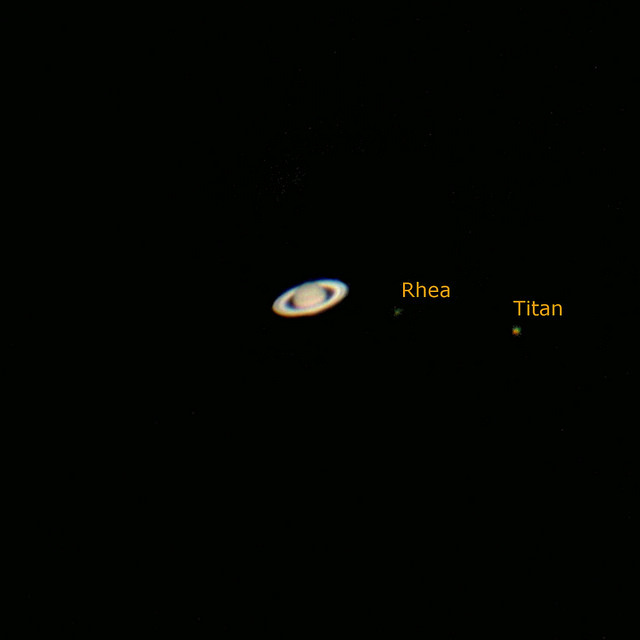
A version of this post was originally published November 24, 2020, at Guy Ottewell’s blog. Reprinted here with permission. Additional links and info via the editors of EarthSky.
Jupiter and Saturn keep drawing nearer to each other on our sky’s dome, as we approach their great conjunction on December 21, 2020. At their closest, the two giant worlds will appear only 1/5 of a moon-diameter apart. Will they appear to the eye as a merging of two bright “stars” (really, planets with magnitudes of -2.0 and 0.7) into a single, even-more-brilliant “star” that seems stretched out northward? Or will the moon illusion (which happens with stars, too) cause them to look farther apart to the eye than they actually are?
Either way, they’ll be spectacular to the eye. We thought you would also enjoy knowing where their moons will be around the time of the conjunction. That’s what the illustrations above show.
The illustrations above show a highly magnified view of the Jupiter-Saturn conjunction on December 20, 2020, and December 21, as these worlds would look through a powerful telescope (and in a dark sky) with a field of view only a fifth of a degree wide. If you hold out your index finger (or your little finger, if you have big hands) at arm’s length, it appears about one degree wide. So this telescope field is a fifth the size of your finger at an arm’s length distance.
The charts are set for a time shortly after sunset in North America, central time. So, on the evening of December 20, Jupiter has yet to catch up with Saturn, and on the evening of December 21 it has just passed. But even a day away from these two dates, the planets are still close.
Will you see them like this – two giant planets with their whirling satellite systems at once – if your telescope is strong enough? It’ll be a tough observation, with Jupiter and Saturn in a twilight sky. Look below for some tools for finding the moons of Saturn, or Jupiter, on any date.
Most conjunctions of bright planets and stars are much wider than the December 21, 2020, Saturn-Jupiter conjunction. That is, the objects in conjunction don’t get as close to each other. Thus, illustrations of the type at the top of this post would have to have 5-degree or 10-degree fields, in which we couldn’t possibly show planets at their true size.
But here, Jupiter and Saturn are shown as they might appear – under ideal conditions of magnification and darkness – through a telescope during the conjunction. Physically, Jupiter and Saturn are about 11 and 9 times as wide as Earth. But they are about 5.92 and 10.82 astronomical units (AU) from Earth, respectively. One AU equals about 93 million miles or 150 million kilometers.
In this magnified view we can also show the major satellites – the moons – though they will have to be exaggerated in size or they would indeed be too small to see. If you’re looking in a dark sky, which may or may not be the case during the conjunction, you can glimpse Jupiter’s largest Galilean moons – and possibly Saturn’s large moon Titan – with binoculars and small telescopes as starlike points. The smaller moons of Saturn are harder to see through small telescopes. To avoid crowding, the inner four Saturnian satellites are here labeled with numbers (they are: Mimas, Enceladus, Tethys, and Dione).


Tools for seeing the moons of Saturn and Jupiter
Jupiter and Saturn’s moons will be tougher to observe in late December than they’ve been in recent months, because Jupiter and Saturn will be in twilight. The guides below might be more useful for 2021, when these worlds will emerge back into the eastern sky before dawn and afterward spend another entire year near each other on our sky’s dome … but not as near as on December 21, 2020!
If you want to see Saturn’s moons, try SkyandTelescope.com’s mobile app SaturnMoons. Or try their interactive observing tool for finding Saturn’s moons.
Jupiter’s moons are easier to spot and fun to watch. Here’s an interactive tool and app for Jupiter’s moons.
Bottom line: Charts showing a magnified (telescopic) view of Jupiter and Saturn at their December 21, 2020, conjunction, via astronomer Guy Ottewell.
Read more on the December 21, 2020, Jupiter-Saturn conjunction











